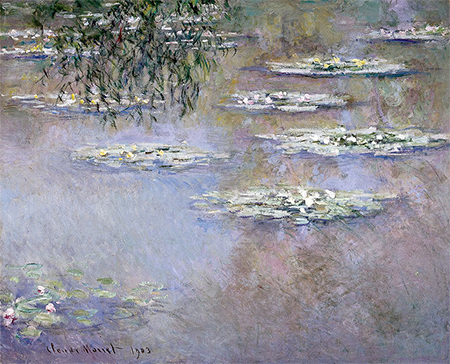
There are three physical spaces I prefer to all others: art museums, baseball stadiums, and libraries/bookstores. There is something about roaming through stacks of books (particularly in a good used bookstore) that feels particularly comforting to me. Ballparks get me caught up in dreams of community and continuity, as if I’m at the Delphi theatre 2,500 years ago. In libraries and stadiums, time stops for me.
But art museums are my bread and butter and the most artcentric spaces on the planet. A visit to one — especially a museum I have never visited before — is the ultimate destination for me. Nothing intrigues me more than discovering I have to be in Dayton Ohio for some reason, and will therefore get to visit the Dayton Art Institute for the first time. Even if I know little about it’s collection — I think I did know it had a good Monet "Waterlilies” — I can visit its website, do a little research, google map it to see how far it sits from my hotel, and generally scope out my visit. I’ve developed a way of visiting a museum for the first time (and also use this procedure for the first run through of a large temporary exhibition). I walk through every room in the entire collection without stopping, in chronological order if possible, just to get a sense of the collection’s breadth, sort of like scanning the whole menu at a restaurant, getting a game plan as to how I can maximize my time in the museum for the few hours I have to experience it. Then I go back to the beginning and work my way through it. I can only concentrate to the degree I need to for about 90 minutes at a time, then I have to take about a break. I sit on a bench or visit the museum store and just veg out for a while, recharge, and then continue.
This works for a small or a mid-size museum (like the DAI), and I can usually achieve a good visit in about 2 1/2 or 3 hours. The last thing I do is walk quickly again through the entire collection, to see if there’s anything I want briefly to see again, or perhaps overlooked, and look more closely at the entire installation of the rooms rather than just accessing it by looking at each artwork.
Of course, this procedure doesn’t work for mega-museums such as the Metropolitan Museum of Art or the Louvre, it’s futile to try to absorb their enormity in a single day. If I’m likely in my life to have only one, maybe two days, to get to visit the Hermitage Museum in St. Petersburg then I will perform a kind of cultural triage. I still do the run through first, but then decide if I’m going to concentrate on Renaissance Art or Cezanne, etc., and accept leaving whole sections of the museum barely observed. Such museums, though, are the exception. I confess, in terms of the experience of a one-day visitor who wants a sense of a museum's totality, to a preference for those small and mid-size museums. While I could never visit the Hermitage enough, I like that I don’t particularly sense that I have to go back to Dayton.
I suppose, like many of you, I’m one of those who within 24 hours of arrival in a city is in its art museum, be it Seattle or Sarasota, Denver or Detroit, etc. You learn a lot about a city by its art museum, it shows you what local artists have been looking at for years, it tells you about local collectors, etc. The argument can be made that one can tell much about the history of art in New York and Chicago by the fact that the former has Picasso’s "Demoiselles d’Avignon" over at MOMA, and the latter has Seurat’s "A Sunday on La Grande Jatte at the Art” highlighting the Art Institute of Chicago. Paintings as visually profound as these two can seep into the mind and hands of a number of the artists who get to experience them regularly.
One of the great aspects of preferring art museums to almost all other spaces and venues is that you can never see them all. It’s a source of some embarrassment and also some hope for the future that I have yet to visit the Albright-Knox Art Gallery in Buffalo, the Allen Memorial Art Museum at Oberlin College in Ohio, the Hammer Museum in L.A., the Sterling and Frances Clark Art Institute in Williamstown, Massachusetts or (and this really is embarrassing) the Kimbell Art Museum in Fort Worth. If you see me walking quickly through one of these in the months or years ahead, give me some space, I’ve got work to do.
